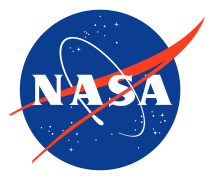Living With a Star
Living With a Star (LWS) is a NASA scientific program to study those aspects of the connected Sun-Earth system that directly affect life and society. LWS is a crosscutting initiative with goals and objectives relevant to NASA's Exploration Initiative, as well as to NASA's Strategic Enterprises. The program is managed by the Heliophysics Science Division of NASA's Science Mission Directorate.
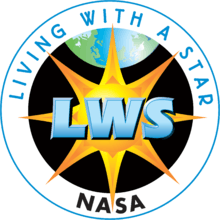
LWS is composed of three major components: scientific investigations on spaceflight platforms study different regions of the Sun, interplanetary space, and geospace; an applied science Space Environment Testbeds program where protocols and components are tested; and a Targeted Research and Technology Program. Major spacecraft include the Van Allen Probes, the Solar Dynamics Observatory, and the Parker Solar Probe
LWS was started in 2001 and is still active in the early 2020s
Overview and history
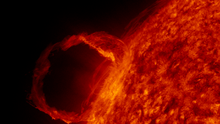
Living With a Star was proposed in 2000 and established with funding in the fall of 2001.[1] At the same time an international collaboration was also established, International Living With a Star program that is conducted with the Interagency Consultative Group task force.[1] The first ILWS meeting was held in 2002.[1]
Another component of LWS, is the Targeted Research & Technology program.[2]
Areas of study for LWS include:[3]
- The Sun
- Space weather
- Explorers Program
- Magnetosphere
- Heliosphere
- Living with a Star
- Solar eclipses
Objectives
The program is focused on understanding the relationship between the Sun and the Earth, a goal that is tackled across several disciplines and areas of study,[3]
Summary:[3]
- Space Science
- Earth Science
- Human Exploration and Development
- Aeronautics and Space Transportation
Spaceflight segment
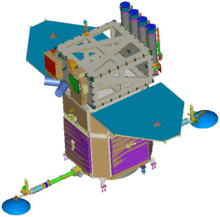
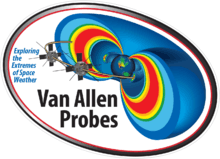
The first two science missions have launched: Solar Dynamics Observatory (SDO) and Van Allen Probes. The SDO mission launched on February 11, 2010, and the Van Allen Probes mission launched on August 30, 2012. Mission have included Balloon Array for Radiation-belt Relativistic Electron Losses (BARREL), Space Environment Testbeds (SET), Space Environment Testbeds, the Solar Orbiter Collaboration (SOC), and Parker Solar Probe (PSP).[4]
Science requirements and conceptual mission implementation have been defined for the Ionosphere-Thermosphere Storm Probes (ITSP) and the Solar Sentinels.
The Parker Solar Probe (Formerly Solar Probe+) was launched by a Delta IV Heavy on August 12, 2018 from Florida, USA.[5][6]
Space Environment Testbeds
SET uses existing data and new data from low-cost SET missions to achieve the following: Define the mechanisms for induced space environment and effects; reduce uncertainties in the definitions of the induced environment and effects on spacecraft and their payloads; and to improve design and operations guidelines and test protocols so that spacecraft anomalies and failures due to environmental effects during operations are reduced.
The goal of this spacecraft is to understand the nature of space environment and how that environment impacts spacecraft.[7]
Targeted Research and Technology
With the 2001 inception of the LWS Program, new opportunities were created for a systematic, goal-oriented research program targeting those aspects of the Sun-Earth system that affect life and society. To provide immediate progress toward achieving the LWS goals, the Targeted Research and Technology (TR&T) component of the program was developed.[2] The TR&T element has solicited five rounds of proposals seeking quantitative understanding and predictive capability throughout the system. TR&T has funded independent research awards, focused science topic panels, and strategic capability challenges to enable a cross-disciplinary, integrated, system-wide understanding of how the Sun varies, and how Earth and planets respond. The focused science topic panels are a novel approach to collaborative science, and initial results appear promising.
Missions
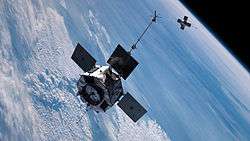
The following missions are associated with the Living With a Star program, with launch dates indicated.[8]
- February 2010 – Solar Dynamics Observatory (SDO)
- August 2012 – Van Allen Probes
- December 2012/December 2013 – Balloon Array for Radiation-belt Relativistic Electron Losses (BARREL)
- January 2018 – Space Environment Testbeds (SET)
- July 2018 – Parker Solar Probe - Previously known as Solar Probe Plus
- 2020 – Solar Orbiter
References
- "International Living With a Star (ILWS) History". ilwsonline.org. Retrieved 2018-08-18.
- "LWS - Targeted Research and Technology - TR&T". lwstrt.gsfc.nasa.gov. Retrieved 2018-08-18.
- "Living With a Star | Science Mission Directorate". science.nasa.gov. Retrieved 2018-08-18.
- Living With a Star Program Missions
- Brown, Geoffrey; Brown, Dwayne; Fox, Karen (August 12, 2018). "Parker Solar Probe Launches on Historic Journey to Touch the Sun". Parker Solar Probe. Retrieved August 18, 2018.
- "NASA Launches Daring Solar Probe Mission to Kiss the Sun". Space.com. Retrieved 2018-08-18.
- "SET-1 | Science Mission Directorate". science.nasa.gov. Retrieved 2018-08-18.
- "Missions". Living With a Star Program. NASA / Goddard Space Flight Center. Retrieved April 11, 2017.
External links
- Living With a Star website at NASA.gov
